Effect of Pressure and Particle Size During Aluminum Oxide Air Abrasion on the Flexural Strength of Disperse-Filled Composite and Polymer-Infiltrated Ceramic Network Materials
Abstract
1. Introduction
2. Materials and Methods
3. Results
4. Discussion
5. Conclusions
Author Contributions
Funding
Conflicts of Interest
References
- Kunii, J.; Hotta, Y.; Tamaki, Y.; Ozawa, A.; Kobayashi, Y.; Fujishima, A.; Miyazaki, T.; Fujiwara, T. Effect of sintering on the marginal and internal fit of CAD/CAM-fabricated zirconia frameworks. Dent. Mater. J. 2007, 26, 820–826. [Google Scholar] [CrossRef]
- Strub, J.R.; Rekow, E.D.; Witkowski, S. Computer-aided design and fabrication of dental restorations: Current systems and future possibilities. J. Am. Dent. Assoc. 2006, 137, 1289–1296. [Google Scholar] [CrossRef]
- Duarte, S.; Sartori, N.; Phark, J.H. Ceramic-reinforced polymers: CAD/CAM hybrid restorative materials. Curr. Oral Health Rep. 2016, 3, 198–202. [Google Scholar] [CrossRef]
- Nguyen, J.F.; Migonney, V.; Ruse, N.D.; Sadoun, M. Properties of experimental urethane dimethacrylate-based dental resin composite blocks obtained via thermo-polymerization under high pressure. Dent. Mater. 2013, 29, 535–541. [Google Scholar] [CrossRef] [PubMed]
- Della Bona, A.; Corazza, P.H.; Zhang, Y. Characterization of a polymer-infiltrated ceramic-network material. Dent. Mater. 2014, 30, 564–569. [Google Scholar] [CrossRef]
- Nguyen, J.F.; Ruse, D.; Phan, A.C.; Sadoun, M.J. High-temperature-pressure polymerized resin-infiltrated ceramic networks. J. Dent. Res. 2014, 93, 62–67. [Google Scholar] [CrossRef] [PubMed]
- Mörmann, W.H.; Stawarczyk, B.; Ender, A.; Sener, B.; Attin, T.; Mehl, A. Wear characteristics of current aesthetic dental restorative CAD/CAM materials: Two-body wear, gloss retention, roughness and Martens hardness. J. Mech. Behav. Biomed. Mater. 2013, 20, 113–125. [Google Scholar] [CrossRef]
- Lawson, N.C.; Bansal, R.; Burgess, J.O. Wear, strength, modulus and hardness of CAD/CAM restorative materials. Dent. Mater. 2016, 32, e275–e283. [Google Scholar] [CrossRef] [PubMed]
- Azarbal, A.; Azarbal, M.; Engelmeier, R.L.; Kunkel, T.C. Marginal fit comparison of CAD/CAM crowns milled from two different materials. J. Prosthodont. 2018, 27, 421–428. [Google Scholar] [CrossRef]
- Bähr, N.; Keul, C.; Edelhoff, D.; Eichberger, M.; Roos, M.; Gernet, W.; Stawarczyk, B. Effect of different adhesives combined with two resin composite cements on shear bond strength to polymeric CAD/CAM materials. Dent. Mater. J. 2013, 32, 492–501. [Google Scholar] [CrossRef] [PubMed]
- Krejci, I.; Daher, R. Stress distribution difference between Lava Ultimate full crowns and IPS e.max CAD full crowns on a natural tooth and on tooth-shaped implant abutments. Odontology 2017, 105, 254–256. [Google Scholar] [CrossRef] [PubMed]
- Stawarczyk, B.; Stich, N.; Eichberger, M.; Edelhoff, D.; Roos, M.; Gernet, W.; Keul, C. Long-term tensile bond strength of differently cemented nanocomposite CAD/CAM crowns on dentin abutment. Dent. Mater. 2014, 30, 334–342. [Google Scholar] [CrossRef] [PubMed]
- Campos, F.; Almeida, C.S.; Rippe, M.P.; De Melo, R.M.; Valandro, L.F.; Bottino, M.A. Resin bonding to a hybrid ceramic: Effects of surface treatments and aging. Oper. Dent. 2016, 41, 171–178. [Google Scholar] [CrossRef] [PubMed]
- Marshall, S.J.; Bayne, S.C.; Baier, R.; Tomsia, A.P.; Marshall, G.W. A review of adhesion science. Dent. Mater. 2010, 26, e11–e16. [Google Scholar] [CrossRef] [PubMed]
- Yang, B.; Wolfart, S.; Scharnberg, M.; Ludwig, K.; Adelung, R.; Kern, M. Influence of contamination on zirconia ceramic bonding. J. Dent. Res. 2007, 86, 749–753. [Google Scholar] [CrossRef]
- de Castro, H.L.; Corazza, P.H.; de Paes-Júnior, T.A.; Della Bona, A. Influence of Y-TZP ceramic treatment and different resin cements on bond strength to dentin. Dent. Mater. 2012, 28, 1191–1197. [Google Scholar] [CrossRef] [PubMed]
- Nobuaki, A.; Keiichi, Y.; Takashi, S. Effects of air abrasion with alumina or glass beads on surface characteristics of CAD/CAM composite materials and the bond strength of resin cements. J. Appl. Oral Sci. 2015, 23, 629–636. [Google Scholar] [CrossRef] [PubMed]
- Spitznagel, F.A.; Horvath, S.D.; Guess, P.C.; Blatz, M.B. Resin bond to indirect composite and new ceramic/polymer materials: A review of the literature. J. Esthet. Restor. Dent. 2014, 26, 382–393. [Google Scholar] [CrossRef] [PubMed]
- Higashi, M.; Matsumoto, M.; Kawaguchi, A.; Miura, J.; Minamino, T.; Kabetani, T.; Takeshige, F.; Mine, A.; Yatani, H. Bonding effectiveness of self-adhesive and conventional-type adhesive resin cements to CAD/CAM resin blocks. Part 1: Effects of sandblasting and silanization. Dent. Mater. J. 2016, 35, 21–28. [Google Scholar] [CrossRef]
- Yoshihara, K.; Nagaoka, N.; Maruo, Y.; Nishigawa, G.; Irie, M.; Yoshida, Y.; Meerbeek, B.V. Sandblasting may damage the surface of composite CAD-CAM blocks. Dent. Mater. 2017, 33, e124–e135. [Google Scholar] [CrossRef]
- Kim, J.E.; Kim, J.H.; Shim, J.S.; Roh, B.D.; Shin, Y. Effect of air-particle pressures on the surface topography and bond strengths of resin cement to the hybrid ceramics. Dent. Mater. J. 2017, 36, 454–460. [Google Scholar] [CrossRef] [PubMed]
- Kurtulmus-Yilmaz, S.; Cengiz, E.; Ongun, S.; Karakaya, I. The effect of surface treatments on the mechanical and optical behaviors of CAD/CAM restorative materials. J. Prosthodont. 2019, 28, e496–e503. [Google Scholar] [CrossRef] [PubMed]
- Strasser, T.; Preis, V.; Behr, M.; Rosentritt, M. Roughness, surface energy, and superficial damages of CAD/CAM materials after surface treatment. Clin. Oral Investig. 2018, 22, 2787–2797. [Google Scholar] [CrossRef] [PubMed]
- International Organization for Standardization. ISO 6872:2015. Dentistry-Ceramic Materials; International Organization for Standardization: Geneva, Switzerland, 2015; Available online: https://www.iso.org/standard/59936.html (accessed on 21 June 2020).
- Gresnigt, M.M.; Ozcan, M.; van den Houten, M.L.; Schipper, L.; Cune, M.S. Fracture strength, failure type and Weibull characteristics of lithium disilicate and multiphase resin composite endocrowns under axial and lateral forces. Dent. Mater. 2016, 32, 607–614. [Google Scholar] [CrossRef] [PubMed]
- Yin, R.; Kim, Y.K.; Jang, Y.S.; Lee, J.J.; Lee, M.H.; Bae, T.S. Comparative evaluation of the mechanical properties of CAD/CAM dental blocks. Odontology 2019, 107, 360–367. [Google Scholar] [CrossRef] [PubMed]
- Ludovichetti, F.S.; Trindade, F.Z.; Adabo, G.L.; Pezzato, L.; Fonseca, R.G. Effect of grinding and polishing on the roughness and fracture resistance of cemented CAD-CAM monolithic materials submitted to mechanical aging. J. Prosthet. Dent. 2019, 121, 866 e861–866 e868. [Google Scholar] [CrossRef]
- Yan, Y.; Chen, C.; Chen, B.; Shen, J.; Zhang, H.; Xie, H. Effects of hydrothermal aging, thermal cycling, and water storage on the mechanical properties of a machinable resin-based composite containing nano-zirconia fillers. J. Mech. Behav. Biomed. Mater. 2019, 102, 103522. [Google Scholar] [CrossRef] [PubMed]
- Aarseth, K.A.; Prestløkken, E. Mechanical properties of feed pellets: Weibull analysis. Biosyst. Eng. 2003, 84, 349–361. [Google Scholar] [CrossRef]
- Scherrer, S.S.; Cattani-Lorente, M.; Vittecoq, E.; de Mestral, F.; Griggs, J.A.; Wiskott, H.W. Fatigue behavior in water of Y-TZP zirconia ceramics after abrasion with 30 μm silica-coated alumina particles. Dent. Mater. 2011, 27, e28–e42. [Google Scholar] [CrossRef]
- Kelch, M.; Schulz, J.; Edelhoff, D.; Sener, B.; Stawarczyk, B. Impact of different pretreatments and aging procedures on the flexural strength and phase structure of zirconia ceramics. Dent. Mater. 2019, 35, 1439–1449. [Google Scholar] [CrossRef]
- Okada, M.; Taketa, H.; Torii, Y.; Irie, M.; Matsumoto, T. Optimal sandblasting conditions for conventional-type yttria-stabilized tetragonal zirconia polycrystals. Dent. Mater. 2019, 35, 169–175. [Google Scholar] [CrossRef] [PubMed]
- Zhang, Y.; Lawn, B.R.; Malament, K.A.; Van Thompson, P.; Rekow, E.D. Damage accumulation and fatigue life of particle-abraded ceramics. Int. J. Prosthodont. 2006, 19, 442–448. [Google Scholar]
- Yoshida, K. Influence of alumina air-abrasion for highly translucent partially stabilized zirconia on flexural strength, surface properties, and bond strength of resin cement. J. Appl. Oral Sci. Rev. FOB 2020, 28, e20190371. [Google Scholar] [CrossRef] [PubMed]
- Kosmač, T.; Oblak, Č.; Jevnikar, P.; Funduk, N.; Marion, L. Strength and reliability of surface treated Y-TZP dental ceramics. J. Biomed. Mater. Res. 2000, 53, 304–313. [Google Scholar] [CrossRef]
- Gonzaga, C.C.; Cesar, P.F.; Miranda, W.G., Jr.; Yoshimura, H.N. Slow crack growth and reliability of dental ceramics. Dent. Mater. 2011, 27, 394–406. [Google Scholar] [CrossRef] [PubMed]
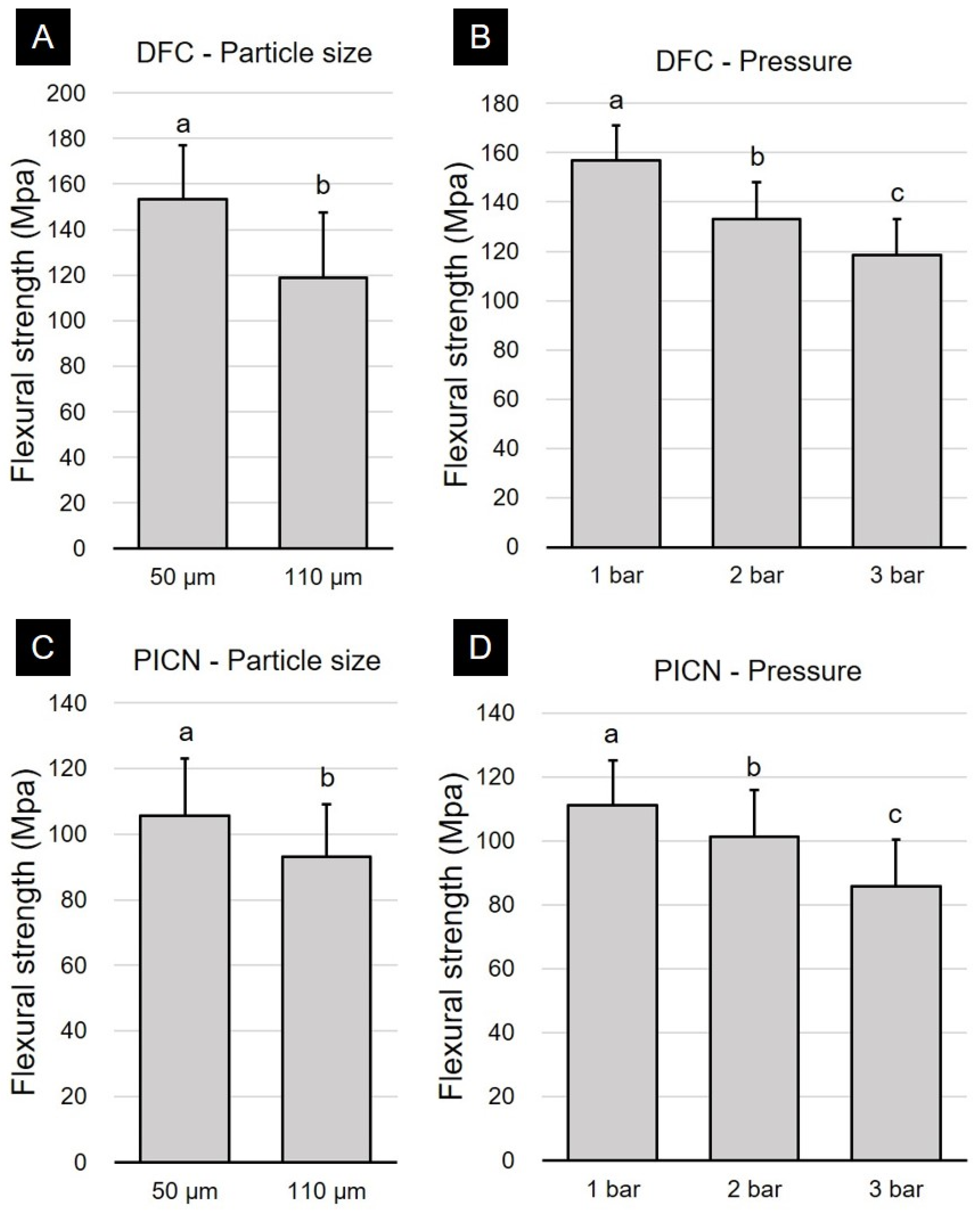
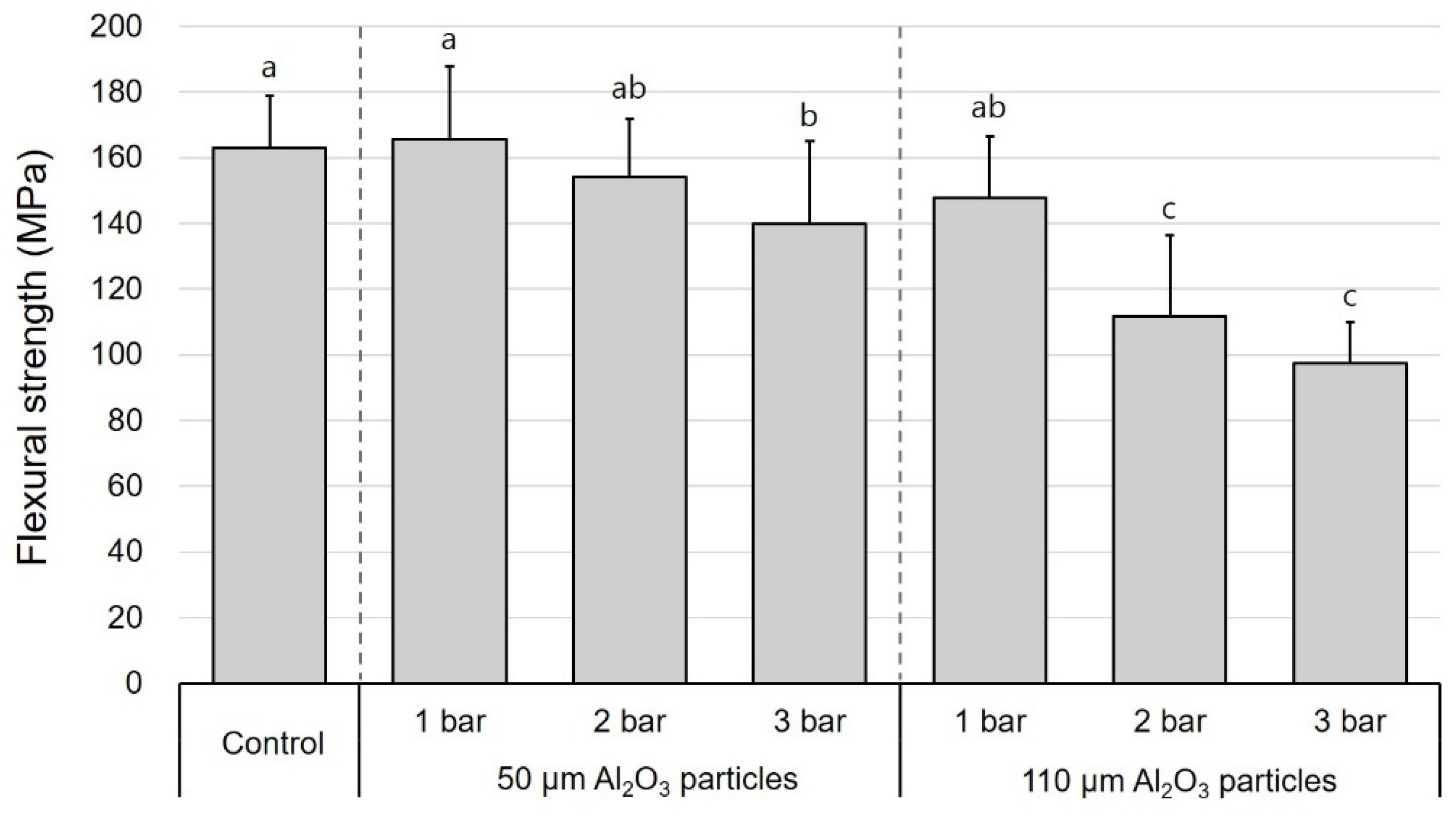
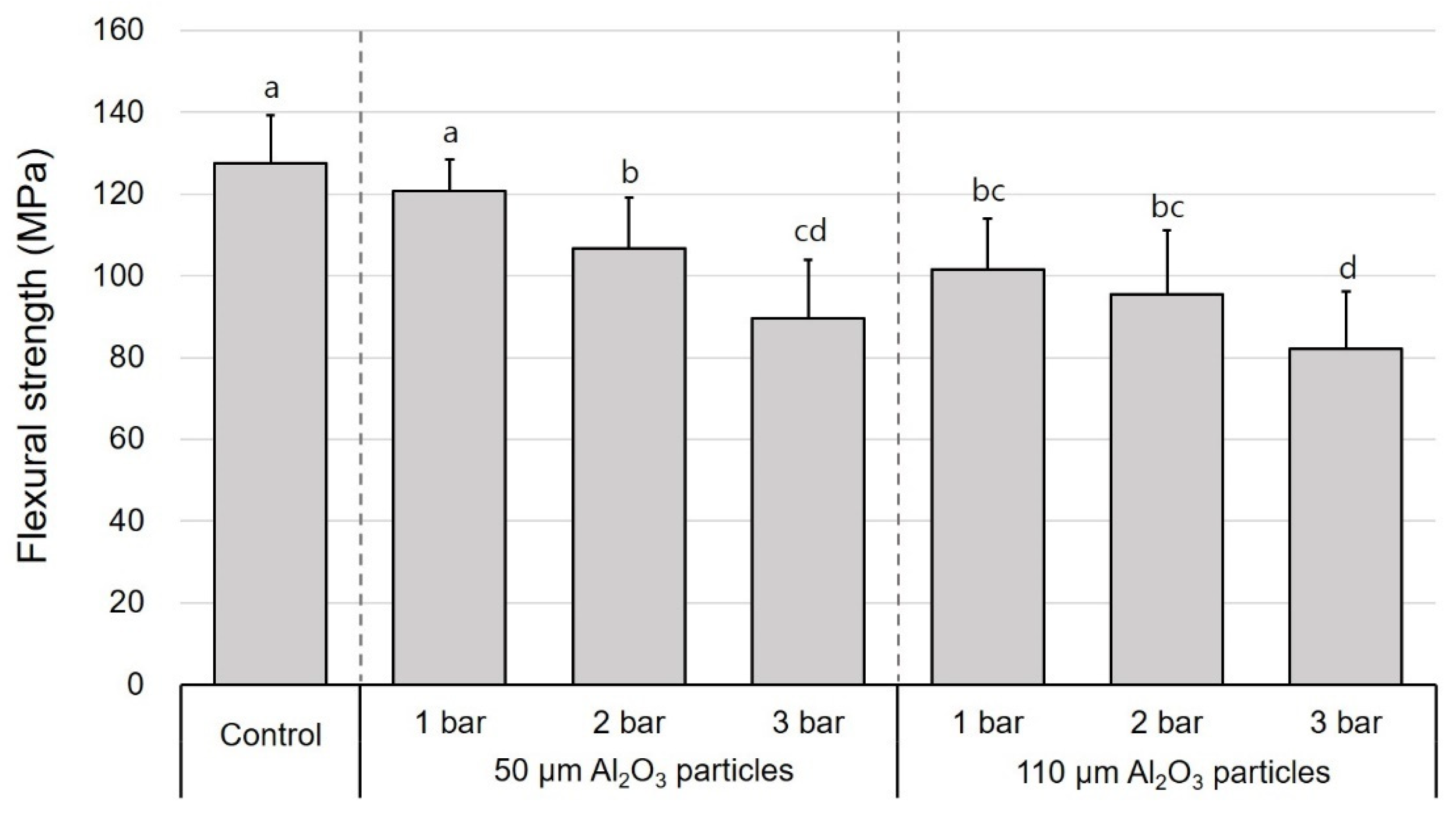
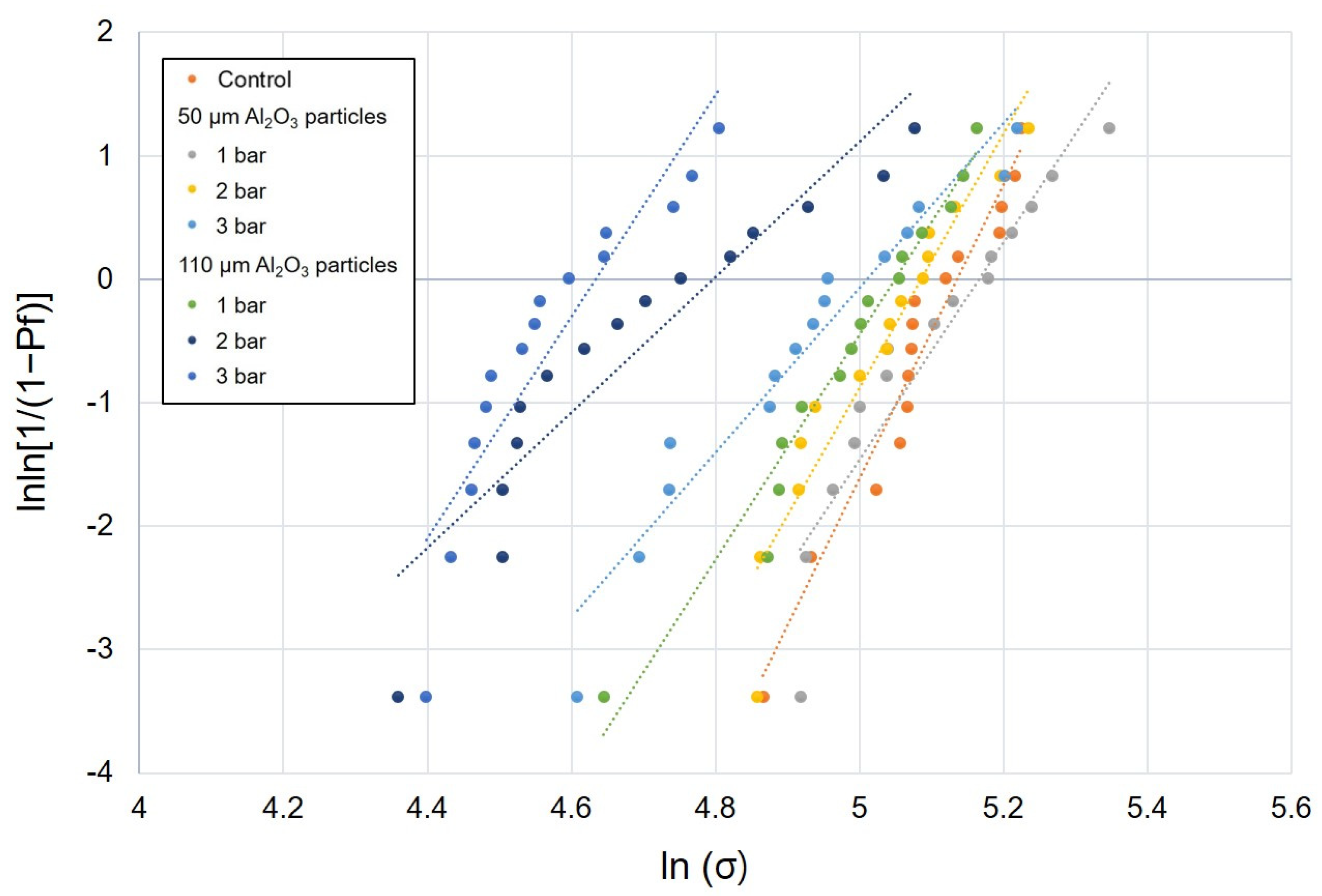

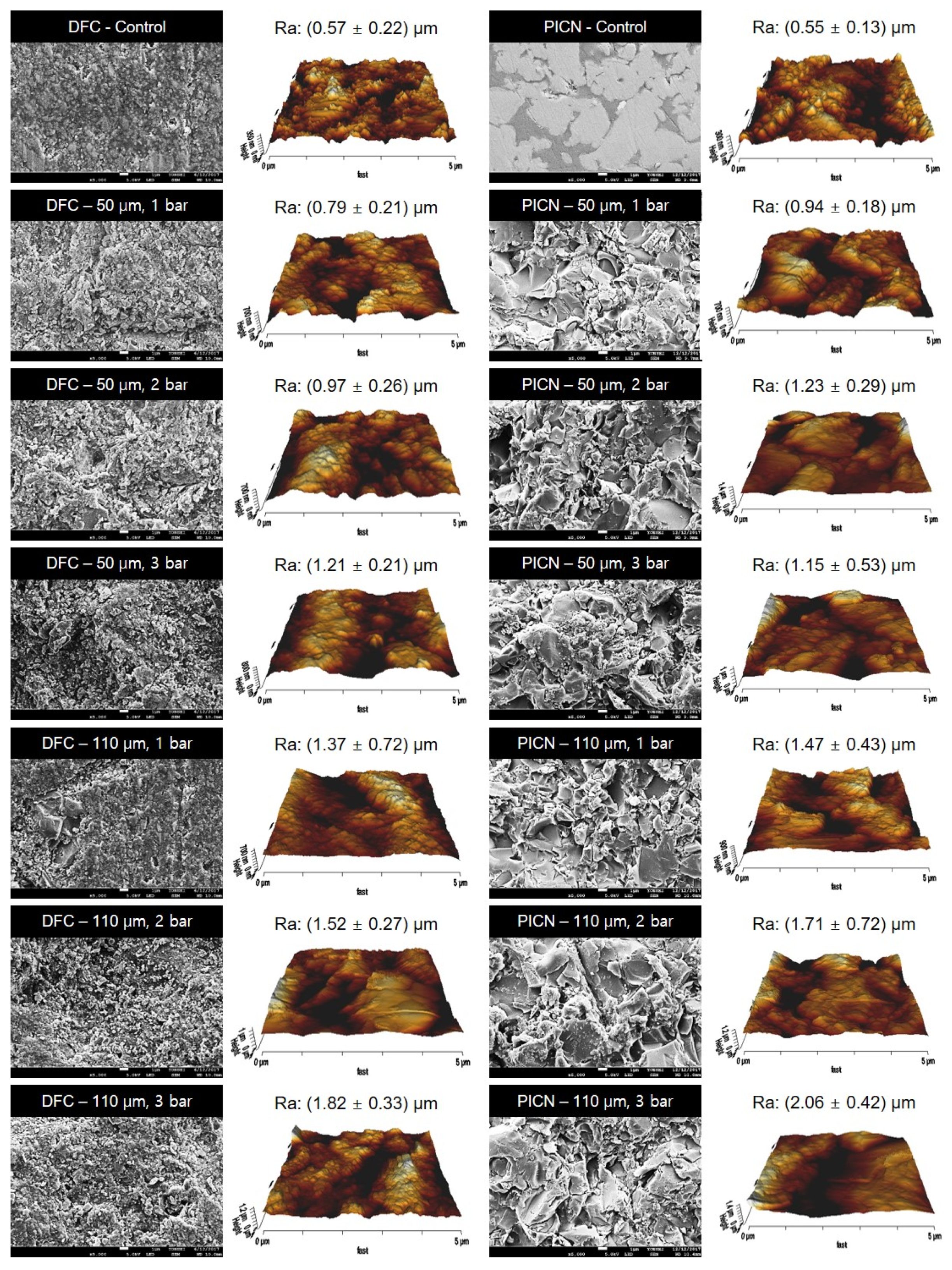
| Flexural Strength (MPa) | m (95% CI) | σ0 (MPa) | |||
|---|---|---|---|---|---|
| DFC (MAZIC Duro) | Control | 162.9 (16.0) Aa | 11.9 (10.3–13.6) | 169.9 | |
| 50 µm | 1 bar | 165.8 (22.2) Aa | 8.8 (7.0–10.6) | 175.2 | |
| 2 bar | 154.1 (17.8) ABa | 10.3 (8.4–12.1) | 161.7 | ||
| 3 bar | 139.9 (25.0) Ba | 6.7 (5.7–7.7) | 149.9 | ||
| 110 µm | 1 bar | 147.9 (18.6) ABa | 9.1 (8.1–10.1) | 156.0 | |
| 2 bar | 111.8 (24.5) Ca | 5.5 (4.2–6.7) | 121.2 | ||
| 3 bar | 97.4 (12.7) Ca | 9.0 (6.6–11.3) | 102.9 | ||
| PICN (Vita Enamic) | Control | 127.5 (11.7) Ab | 12.5 (9.8–15.2) | 132.8 | |
| 50 µm | 1 bar | 120.8 (7.7) Ab | 18.6 (15.3–22.0) | 124.3 | |
| 2 bar | 106.7 (12.4) Bb | 10.0 (8.8–11.2) | 112.1 | ||
| 3 bar | 89.6 (14.4) CDb | 7.3 (6.7–7.9) | 95.5 | ||
| 110 µm | 1 bar | 101.6 (12.4) BCb | 9.4 (6.8–11.9) | 107.1 | |
| 2 bar | 95.6 (15.5) BCb | 6.9 (6.0–7.7) | 102.3 | ||
| 3 bar | 82.2 (14.1) Db | 6.7 (6.3–7.1) | 88.0 | ||
| Ra (µm) | Rq (µm) | Rt (µm) | |||
|---|---|---|---|---|---|
| DFC (MAZIC Duro) | Control | 0.57 ± 0.22 a | 0.70 ± 0.26 a | 3.10 ± 1.05 a | |
| 50 µm | 1 bar | 0.79 ± 0.21 ab | 0.96 ± 0.25 ab | 3.95 ± 0.92 ab | |
| 2 bar | 0.97 ± 0.26 bc | 1.18 ± 0.28 bc | 5.14 ± 1.11 bc | ||
| 3 bar | 1.21 ± 0.21 bcd | 1.45 ± 0.26 bcd | 5.78 ± 1.19 bc | ||
| 110 µm | 1 bar | 1.37 ± 0.72 cde | 1.70 ± 0.86 cde | 5.76 ± 2.31 bc | |
| 2 bar | 1.52 ± 0.27 de | 1.83 ± 0.32 de | 6.74 ± 1.32 c | ||
| 3 bar | 1.82 ± 0.33 e | 2.24 ± 0.30 e | 9.62 ± 1.44 d | ||
| PICN (Vita Enamic) | Control | 0.55 ± 0.13 a | 0.65 ± 0.14 a | 2.68 ± 0.34 a | |
| 50 µm | 1 bar | 0.94 ± 0.18 b | 1.16 ± 0.20 b | 4.81 ± 0.70 b | |
| 2 bar | 1.23 ± 0.29 bc | 1.48 ± 0.36 bc | 5.89 ± 1.06 bc | ||
| 3 bar | 1.15 ± 0.53 bc | 1.49 ± 0.65 bc | 6.65 ± 3.00 bcd | ||
| 110 µm | 1 bar | 1.47 ± 0.43 bc | 1.78 ± 0.51 bcd | 6.59 ± 1.54 bcd | |
| 2 bar | 1.71 ± 0.72 cd | 2.00 ± 0.79 cd | 7.72 ± 2.20 cd | ||
| 3 bar | 2.06 ± 0.42 d | 2.38 ± 0.47 d | 8.26 ± 1.41 d | ||
© 2020 by the authors. Licensee MDPI, Basel, Switzerland. This article is an open access article distributed under the terms and conditions of the Creative Commons Attribution (CC BY) license (http://creativecommons.org/licenses/by/4.0/).
Share and Cite
Kim, J.-E.; Lim, J.-H.; Kang, Y.-J.; Kim, J.-H.; Shim, J.-S. Effect of Pressure and Particle Size During Aluminum Oxide Air Abrasion on the Flexural Strength of Disperse-Filled Composite and Polymer-Infiltrated Ceramic Network Materials. Polymers 2020, 12, 1396. https://doi.org/10.3390/polym12061396
Kim J-E, Lim J-H, Kang Y-J, Kim J-H, Shim J-S. Effect of Pressure and Particle Size During Aluminum Oxide Air Abrasion on the Flexural Strength of Disperse-Filled Composite and Polymer-Infiltrated Ceramic Network Materials. Polymers. 2020; 12(6):1396. https://doi.org/10.3390/polym12061396
Chicago/Turabian StyleKim, Jong-Eun, Jung-Hwa Lim, You-Jung Kang, Jee-Hwan Kim, and June-Sung Shim. 2020. "Effect of Pressure and Particle Size During Aluminum Oxide Air Abrasion on the Flexural Strength of Disperse-Filled Composite and Polymer-Infiltrated Ceramic Network Materials" Polymers 12, no. 6: 1396. https://doi.org/10.3390/polym12061396
APA StyleKim, J.-E., Lim, J.-H., Kang, Y.-J., Kim, J.-H., & Shim, J.-S. (2020). Effect of Pressure and Particle Size During Aluminum Oxide Air Abrasion on the Flexural Strength of Disperse-Filled Composite and Polymer-Infiltrated Ceramic Network Materials. Polymers, 12(6), 1396. https://doi.org/10.3390/polym12061396






